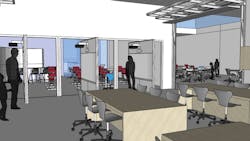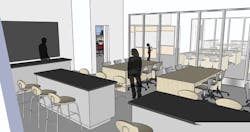Full Steam Ahead
The global economy has “flattened” the world in every aspect of our lives, especially with skills and technology. A new self-reliant workforce of problem-solvers, innovators and critical thinkers drive innovation through a proficiency in science, technology, engineering, arts and mathematics (STEAM) subjects for 21st-century success.
Students need more than traditional content knowledge and study skills to make it in today’s workforce; this change in teaching and learning affects how facilities are designed. In order to design to support the STEAM program, it is essential to understand STEAM and why is it important to provide a STEAM-focused education for our young students.
Engineering and Art
Today’s workplaces, schools, homes and everyday lives are more technological than ever before. According to the National Center for Technological Literacy, people spend 95 percent of their time interacting with some type of technology, yet few people realize the important role engineering has in bringing these products to market.
Labor statisticians forecast that the U.S. economy will call for millions of new professionals in STEAM disciplines within the next 10 years. For example, buildings, furniture, household devices, cell phones and transportation systems are all technologies—designed by engineers to meet needs or wants. Children are our future, so it is vital to foster engineering and technological literacy into their daily learning. Watch children and you’ll see their natural engineering tendencies, fascinated with taking things apart and putting things together. By teaching and learning with a STEAM focus, children’s natural curiosity can be harnessed to promote the learning of engineering and technology concepts.
Using “engineering” when describing activities brings positive associations with the term. Our students must compete in a global economy; a STEAM school equips students with skills that are integrated across disciplines. Hands-on, real-world engineering experiences can invigorate science, technology, engineering, arts and math to motivate students to learn new concepts through relevant applications. Learning about engineering increases an awareness of and access to scientific and technical careers.
By introducing engineering in the early years, we encourage students to consider it as a career and enroll in applicable science, math and arts courses in high school, potentially reversing the declining trend of students pursuing engineering.
How does “art” fit into the engineering pursuit, going from STEM to STEAM? Recently, art and design have been introduced into the STEM format, with wide-ranging support by business, government and academia. Most every element of engineering has a design to it, and that’s usually how consumers identify with a product—what it looks like.
For example, smartphones, appliances, automobiles and machinery that sell well integrate appearance and functionality; it doesn’t just work well, it looks good—that is essential for competitive advantage.
Staff Development
STEAM school curriculum incorporates interdisciplinary project-based and other standards-based learning activities that integrate inquiry/exploration, creative expression and problem-solving, use of technology and engineering processes, and understanding of societal realities. It is becoming common practice for teachers to participate in collaborative training and planning efforts with universities and community partners to synthesize curricula into the STEAM concepts.
Training sessions engage teachers in hands-on experiences with new engineering units, focusing on areas such as defining STEAM, disciplinary literacy, inquiry-based instruction understanding engineering. As part of the process, staff determines curricular areas, and develops assessment and evaluation processes for student learning. It is essential to involve the architect in staff development efforts to describe how spaces are intended to be used, how furniture can be arranged, and how spaces can be blended together for various activities. In addition, architects have the opportunity to show the building’s sustainability features, and to encourage staff to use the building as a teaching tool.
Designing for STEAM
To support STEAM, facility designs should create an environment that promotes collaborative experiences in math, technology, science and the arts, focusing on project-based (instead of subject-based) curricula, promoting discovery and inquiry. Learning spaces flowing into one another enhance the curricula, engaging students into their natural tendency to explore.
Remote, self-contained labs are limiting; designing every space as a potential lab or studio environment for experimentation is the STEAM approach. Turn more toward the design trend seen in urban museums—spaces that celebrate interactive learning. Design a variety of spaces that stimulate discovery (indoor and outdoor), collaboration, reflection, presentation, lecture, seminar, reference activity and experimentation. The design should stimulate children’s various intelligences (bodily, spatial, interpersonal, etc.) through a variety of colors, sizes, materials, transparency and flexibility.
Spaces should combine science and art for real-world experiments. Appropriate furniture provides opportunities for flexibility to convert space instantly for large-group, small-group, roundtable, U-shaped or individualized learning activities. Integrating portable technology and movable workstations promotes hands-on learning. Free the teacher from the traditional “front” desk; provide staff planning spaces for collaborative work across disciplines to support STEAM. Display student work to show talent, progress and to stimulate others. Personalizing a space provides students with “something they call their own” in school, from a locker to a laptop.
A successful design starts with planning; seeking input from staff, students, parents and specialists to support the STEAM purpose. Successful STEAM school designs support and enhance hands-on, real-world engineering experiences that intensify math, science, the arts, and other content areas and motivate students to learn these concepts in relevant problem-based applications.
Sidebar: A New STEAM School ExampleThe 117,500-square-foot I.J. Holton Intermediate (grades 5/6) STEAM School for Austin (Minn.) Public Schools, will serve as a teaching tool itself this fall and is designed specifically to support STEAM in ways that harness a child’s natural curiosity. The building conveys various features to reduce consumption of energy and natural resources. Signage is designed throughout the building interior, posting features of the school including:
•How components save energy (i.e., mechanical and electrical systems).
•How systems conserve water (i.e., automatic flush valves and faucets).
•Why materials were chosen for particular areas (i.e., ground concrete vs. tile; acoustics)
•How the building is put together (i.e., ceiling areas of the building systems are exposed).
•How the building is ventilated (i.e., selected areas have exposed ventilation ductwork).
Students learn that sustainability is integral to the design, with an efficient two-story plan that reduces the building footprint, and other sustainability highlights:
•Tall windows and sloped ceilings at classroom exterior walls bring daylight deep into the space.
•Continuous clerestory windows provide natural light to “interior” spaces.
•Polished concrete floors and burnished masonry walls reduce long-term maintenance costs.
•Acoustic treatment in ceilings, walls and furnishings reduce noise and distractions.
•Occupancy sensors, recovery units and ice-storage mechanical systems enhance energy efficiency.
“Foot” and “meter” markings are inlaid in terrazzo flooring and feature walls, using hallways as a teaching tool, providing students a sense of measurement, conversion and scale of space. Students will use this tool to conduct real-life experiments involving kinetics, distances, projectiles, etc.
The school embraces “anytime, anyplace” technology use, resulting in decentralizing the media center, and resituating it to where students conduct experiments and engage in on-task research (a small media center is provided with 4,000 volumes). Instead, six learning communities are designed for teaming with breakout areas situated centrally in each community and adjacent to science spaces, supporting research, and development and creating a “think tank” environment.
Students, with their personal laptops, can move seamlessly from research to a “hands-on” environment without interruption. This informal setting with a variety of furniture, collaboration stations and “walls for writing” enhances the STEAM curriculum further.
Science labs, art studios and tech ed areas only have perimeter casework, with the center open for flexible furniture on casters for ease of reconfiguration and creating areas for experiments, displays, presentation and teaming—whatever activity is appropriate to support the lesson. Learning spaces are literally “transparent,” as windows replace solid partitions to “open up to view” the learning activity.
Four flexible science classrooms are situated between the learning communities with horizontal folding doors connecting to the breakout space; “pivot walls” open directly to the adjacent classrooms for increased program flexibility. Operable partitions between classrooms create the ability for various-sized spaces. Pivot walls with integral “technology boards” are integrated in the central classrooms, adjacent to the breakout space. These numerous wall and technology configurations are designed to accommodate the STEAM curriculum and provide a variety of teaching spaces for small- and large-group activities.
Two art studios and two technology labs have display areas for presentation and to showcase student work. The exterior “tech-court,” situated directly outside the technology labs, accommodates large-scale experiments and projects. Also, to further enhance and support the performing-arts program, three music rooms for band, orchestra/choir and general music are provided, which is integral to the STEAM experience.
Erickson, AIA/NCARB/REFP, is president of ATS&R Planners/Architects/Engineers, Minneapolis, a multi-disciplined firm specializing in pre-K to 12 and post-secondary school planning and design.

